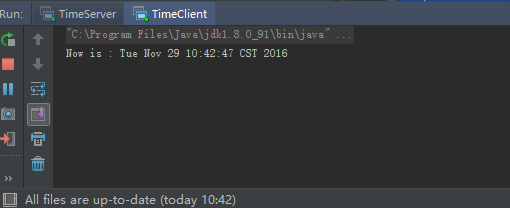《netty权威指南》上的一个入门例子:
服务器端代码:
public class TimeServer {
public void bind(int port){
EventLoopGroup bossGroup = new NioEventLoopGroup();
EventLoopGroup workerGroup = new NioEventLoopGroup();
try {
ServerBootstrap b = new ServerBootstrap();
b.group(bossGroup, workerGroup)
.channel(NioServerSocketChannel.class)
.option(ChannelOption.SO_BACKLOG, 1024)
.childHandler(new ChildChannelHandler());
ChannelFuture f = b.bind(port).sync();
f.channel().closeFuture().sync();
} catch (Exception e) {
e.printStackTrace();
} finally {
bossGroup.shutdownGracefully();
workerGroup.shutdownGracefully();
}
}
private class ChildChannelHandler extends ChannelInitializer<SocketChannel> {
@Override
protected void initChannel(SocketChannel ch) throws Exception {
// TODO Auto-generated method stub
ch.pipeline().addLast(new TimeServerHandler());
}
}
public static void main(String[] args) throws Exception{
// TODO Auto-generated method stub
int port = 8080;
if(args != null && args.length>0) {
try{
port = Integer.valueOf(args[0]);
} catch(NumberFormatException e){
e.printStackTrace();
}
}
new TimeServer().bind(port);
}
}
//服务器端处理类
public class TimeServerHandler extends ChannelHandlerAdapter {
@Override
public void exceptionCaught(ChannelHandlerContext ctx, Throwable cause) throws Exception {
ctx.close();
}
@Override
public void channelRead(ChannelHandlerContext ctx, Object msg) throws Exception {
ByteBuf buf = (ByteBuf) msg;
byte[] req = new byte[buf.readableBytes()];
buf.readBytes(req);
String body = new String(req, "UTF-8");
System.out.println("the time server receive order : " + body);
String currentTime = "Query TIME ORDER".equalsIgnoreCase(body) ? new Date(System.currentTimeMillis()).toString()
: "BAD ORDER";
ByteBuf resp = Unpooled.copiedBuffer(currentTime.getBytes());
ctx.write(resp);
}
@Override
public void channelReadComplete(ChannelHandlerContext ctx) throws Exception {
ctx.flush();
}
}客户端代码:
public class TimeClient {
public void connect(int port, String host) throws Exception {
EventLoopGroup group = new NioEventLoopGroup();
try {
Bootstrap b = new Bootstrap();
b.group(group).channel(NioSocketChannel.class)
.option(ChannelOption.TCP_NODELAY, true)
.handler(new ChannelInitializer<SocketChannel>() {
@Override
protected void initChannel(SocketChannel ch) throws Exception {
// TODO Auto-generated method stub
ch.pipeline().addLast(new TimeClientHandler());
}
});
//发起异步链接操作
ChannelFuture f = b.connect(host, port).sync();
//等待客户端链路关闭
f.channel().closeFuture().sync();
} catch(Exception e) {
e.printStackTrace();
} finally {
group.shutdownGracefully();
}
}
public static void main(String[] args) throws Exception {
// TODO Auto-generated method stub
int port = 8080;
if(args != null && args.length > 0) {
try {
port = Integer.valueOf(args[0]);
} catch (NumberFormatException e) {
e.printStackTrace();
}
}
new TimeClient().connect(port, "127.0.0.1");
}
}
//客户端处理类:
public class TimeClientHandler extends ChannelHandlerAdapter {
private static final Logger logger = Logger.getLogger(TimeClientHandler.class.getName());
private final ByteBuf firstMessage;
public TimeClientHandler() {
byte[] req = "QUERY TIME ORDER".getBytes();
firstMessage = Unpooled.buffer(req.length);
firstMessage.writeBytes(req);
}
@Override
public void exceptionCaught(ChannelHandlerContext ctx, Throwable cause) throws Exception {
logger.warning("Unexpected exception from doownstream : " + cause.getMessage());
ctx.close();
}
@Override
public void channelActive(ChannelHandlerContext ctx) throws Exception {
ctx.writeAndFlush(firstMessage);
}
@Override
public void channelRead(ChannelHandlerContext ctx, Object msg) throws Exception {
ByteBuf buf = (ByteBuf) msg;
byte[] req = new byte[buf.readableBytes()];
buf.readBytes(req);
String body = new String(req, "UTF-8");
System.out.println("Now is : " + body);
}
}运行截图:
java原生NIO的api我大致的看了下,啰嗦的不要不要的,反正都是一些api的使用与理解,个人感觉没必要找罪受,直接上netty来写java的异步操作。
这只是个例子没啥可说的,只说说几个点吧,
NioEventLoopGroup就是创建了一组NIO线程,用于处理事件。
ServerBootstrap类是netty用于启动NIO服务端的辅助类。
在childHandler方法中实例化Handler类,处理网络IO事件(例如:记录日志,消息编码)
总的来说一下,就是按照netty它的逻辑,服务端bind一个服务,客户端connect上服务端,然后服务端和客户端各自都有对应的异步处理方法去处理发送和读取,真心没啥东西,反正你不会直接感受到异步的存在机理,好吧,之后的博客再做深入,这次就到这里。
























 872
872

 被折叠的 条评论
为什么被折叠?
被折叠的 条评论
为什么被折叠?








